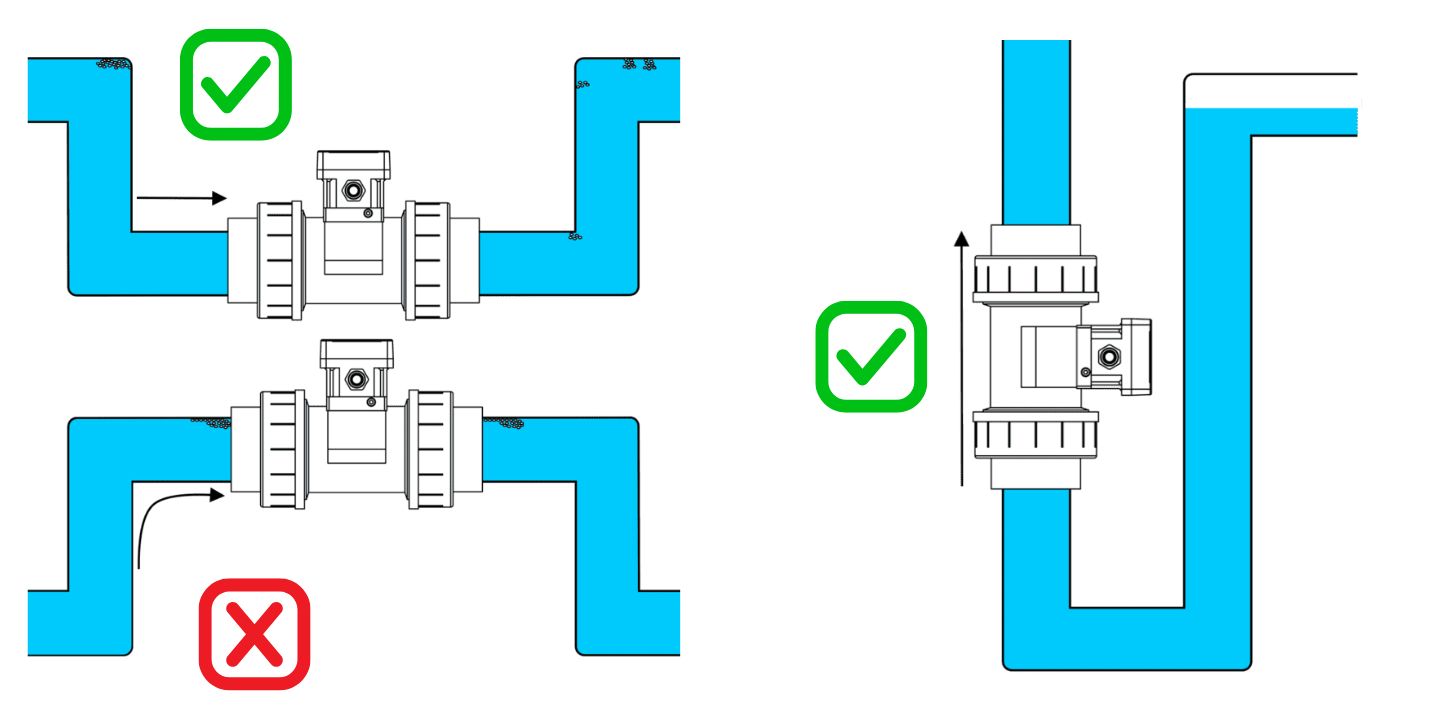유량계는 배관 내 물, 화학액, 공기, 가스 등의 유체 유량을 측정하는 기기입니다. 설치 후 측정값이 이상하거나 불안정하다면, 반드시 기기 고장 때문이 아니라 설치 불량에서 비롯된 경우가 많습니다.
유량계는 측정 원리에 따라 다양한 종류가 있으며, 각 기기별 설치 요건도 조금씩 다릅니다. 본 문서에서는 유량계 설치의 일반적인 권장사항과 함께 주요 유형별 주의사항을 정리했습니다.
가장 간단하고 올바른 설치 방법은 제조사 매뉴얼을 따르는 것입니다. 이와 별개로, 대부분 유량계는 공통 설치 원칙을 지키면 측정 오류를 줄일 수 있습니다.
1 ) 전방 최소 10D, 후방 최소 5D 확보
정확한 측정을 위해 유량계 전후로 충분한 직관 구간을 확보해야 합니다. 일반적으로 전방(유입측)은 배관 내경의 10배(10D), 후방(유출측)은 5배(5D) 이상 직선 배관이 필요합니다.
왜 중요할까요?
연구에 따르면, 전방에 엘보 등 곡관이 있으면 유동이 난류, 소용돌이 상태로 유량계 측정 정확도를 떨어뜨립니다. 직관 구간을 확보하면 유속이 안정되어 보다 신뢰성 있는 측정이 가능합니다.
[1]

예: 내경 4cm 배관의 경우
・전방 직관 길이 = 10 × 4cm = 40cm
・후방 직관 길이 = 5 × 4cm = 20cm
내경(ID)이 불명확하면, 외경(OD)에서 벽 두께를 빼서 계산합니다.
공식: ID = OD - 2 × 벽 두께
[2]
2 ) 밸브나 펌프 후방 설치 피하기
펌프, 컨트롤 밸브, 리듀서, 익스팬더 등은 유동을 교란시켜 측정에 영향을 줍니다. 따라서 유량계는 밸브 전방에 설치하는 것이 권장되며, 불가피할 경우 전방 최소 30D 이상의 직관 구간을 확보해야 합니다.

3 ) 상향 흐름 또는 낮은 위치의 만관 구간에 설치
유량계는 항상 배관이 만관 상태인 곳에 설치해야 합니다. 최고점은 공기 포켓이 생기기 쉬우므로 피하고, U자 배관의 낮은 위치나 수직 상향 배관에 설치하는 것이 이상적입니다.

4 ) 진동 많은 구역 피하기, 실외는 보호 커버 사용
고진동 환경은 일반 유량계의 정확도를 저하시킬 수 있습니다. 특히 전자식 유량계는 강한 자기장 근처(대형 모터, 인버터 등)에서 제로 드리프트, 불안정한 신호가 발생할 수 있습니다.
실외 설치 시에는 직사광선, 고온, 폭우, 눈으로부터 보호하기 위해 커버나 쉘터 사용을 추천합니다.
초음파 유량계
초음파 유량계는 전이 시간형(Transit-time)과 도플러형(Doppler)으로 나뉩니다.
・전이 시간형: 초음파 파동의 상하류 전송 시간 차이를 측정하며, 기포나 고형물이 없는 깨끗한 액체에 적합합니다.
・도플러형: 기포나 부유물이 포함된 유체의 입자, 기포 반사 주파수로 유량을 계산합니다.
➜ 자세히 보기:
Z, V, N, W 설치 방식 이해하기
일체형 클램프온 초음파 유량계는 커플링 젤 없이 간편 설치가 가능하며, 예: LORRIC FU-ES 클램프온 초음파 유량계는 현장 작업자의 설치 편의성을 크게 높입니다.
➜ 제품 보기:
FU-ES 클램프온 초음파 유량계
패들휠 유량계
패들휠 유량계는 유체 흐름으로 회전하는 임펠러를 통해 유량을 측정합니다. 고형물, 찌꺼기에 민감하므로, 상류에 스트레이너나 필터 설치를 추천합니다.
또한, 설치 각도는 수평관에서 45° 또는 135° 기울임이 이상적이며, 12시(상부), 6시(하부), 3시/9시(측면) 설치는 피하는 것이 좋습니다. 상부는 기포, 하부는 침전물, 측면은 비대칭 유동에 의한 편마모가 발생할 수 있기 때문입니다.

전자식 유량계
전자식 유량계는 전도성 액체 전용으로, 항상 만관 및 무기포 상태 유지가 중요합니다. 전극은 3시, 9시 위치로 설치하여 공기 포켓, 침전물 영향을 최소화합니다.
또한, 접지 처리가 필요하며, 대형 모터, 인버터 등의 강한 전자기 간섭원 근처 설치는 피해야 합니다.
[8]
Q1: 설치 후 측정값이 이상합니다. 무엇을 확인해야 할까요?
A: 유량계의 유량 방향 화살표가 실제 유동 방향과 일치하는지, 배관이 만관 상태인지 확인하세요. 항상 제조사 매뉴얼을 따라 설치하세요.
Q2: 유량계 정확도가 낮은 이유는?
A: 잘못된 설치 위치, 기포나 찌꺼기, 불안정한 유속, 정기 보정 미실시, 센서 노후 등이 원인일 수 있습니다. 사용 조건에 맞는 모델 선택과 설치 지침 준수가 중요합니다.
Q3: 측정값 변동이 심할 때 해결법은?
A: 상류 직관 부족, 펌프, 밸브, 엘보 인접 설치가 원인일 수 있습니다. 충분한 직관 확보 또는 플로우 컨디셔너 추가를 고려하세요.
Q4: 유량계에서 누수가 발생할 때는?
A: 인서션형은 O-링(오링) 규격과 상태를 확인하고, 나사형은 PTFE 테이프로 밀봉 후 적정 토크로 조임하세요. 설치 후 압력 테스트로 누수를 점검하세요.